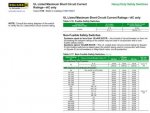Hi Everyone,
Long time reader of this forum but first time posting.
I have a question regarding a transformer installation. Currently there's a 1500KVA transformer installed feeding a 2000A main disconnect. A proposal was written to upgrade to a 3000KVA transformer in order to have room for future expansion. I am reviewing the proposal and everything seems fine with the cable sizing and load side fused protection.
My question is the AIC rating for the 2000A main disconnect. The main disconnect is rated for 100KA or short circuit current rating, which isn't the same as the AIC rating. According to the calculation the max short circuit fault current should be around 62.2KA for the 3000KVA transformer (based on 480V secondary with a 5.8% impedance). If the short circuit current rating is sufficient to carry the fault current, does it matter what the AIC rating is if we size the primary protection of the transformer accordingly? Or do we have to make sure that the AIC for the main disconnect is rated at least 65KA?
Thanks in advance!
Long time reader of this forum but first time posting.
I have a question regarding a transformer installation. Currently there's a 1500KVA transformer installed feeding a 2000A main disconnect. A proposal was written to upgrade to a 3000KVA transformer in order to have room for future expansion. I am reviewing the proposal and everything seems fine with the cable sizing and load side fused protection.
My question is the AIC rating for the 2000A main disconnect. The main disconnect is rated for 100KA or short circuit current rating, which isn't the same as the AIC rating. According to the calculation the max short circuit fault current should be around 62.2KA for the 3000KVA transformer (based on 480V secondary with a 5.8% impedance). If the short circuit current rating is sufficient to carry the fault current, does it matter what the AIC rating is if we size the primary protection of the transformer accordingly? Or do we have to make sure that the AIC for the main disconnect is rated at least 65KA?
Thanks in advance!

